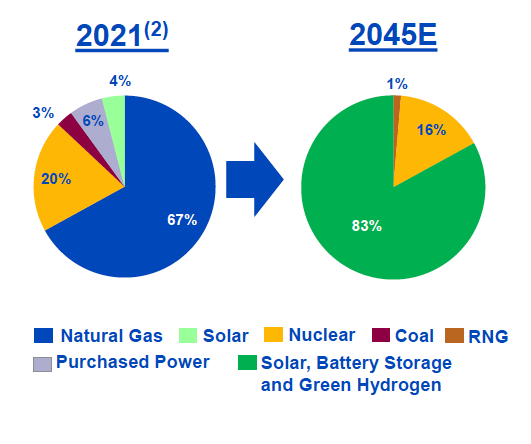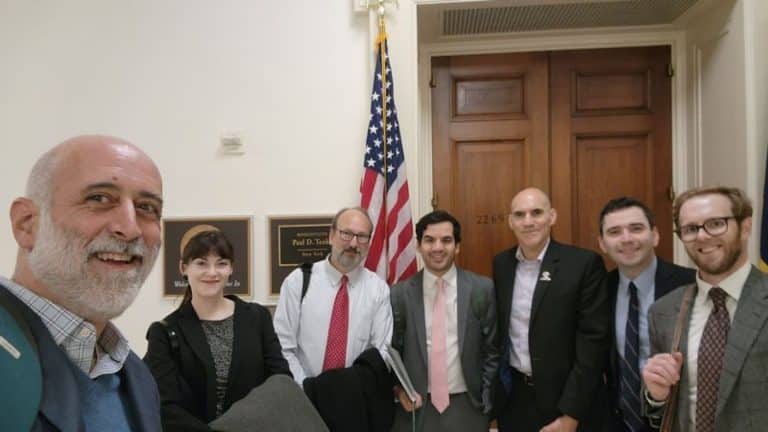NextEra Energy, the parent company of Florida Power & Light Company (FPL), announced a company-wide goal yesterday, June 14, to eliminate carbon emissions from its operations by 2045. NextEra calls the new goal “Real Zero,” and claims it’s the most ambitious carbon emissions reduction goal ever set by an energy producer – and one that would not require carbon offsets.
Highlights for the FPL System
The goal is focused on the following plan:
- FPL plans to be 36% decarbonized by 2025 (using a 2005 emission baseline), 52% by 2030, 62% by 2035 and 83% by 2040, culminating in 100% decarbonization by no later than 2045. It plans to reach these interim targets through modernization of its generation fleet, which will consist of a mix of solar, battery storage, existing nuclear, green hydrogen, and other renewable sources.
- By 2045, FPL would significantly expand its solar capacity, increasing the amount of solar generation on FPL’s system from approximately 4,000 MW today to more than 90,000 MW.
- FPL’s plan is to add more than 50,000 MW of battery storage to its grid, up from 500 MW today.
- FPL would convert 16,000 MW of existing fossil gas units to run on green hydrogen. FPL states that the conversion of these units to green hydrogen is expected to be “cost-effective” for customers. By 2045 FPL’s plan includes 30 GW of excess solar, which it would use to produce approximately 500 million kilograms of green hydrogen through electrolysis.
- FPL will plan to generate up to 6,000 MW of carbon-neutral power with renewable natural gas, which would is equivalent to 2.4% of the volume of fossil gas presently used in FPL plants.
- There are references in the plan about the need for a constructive regulatory environment and approval by regulators, acknowledging that these investments will have to be found reasonable and prudent by the Florida Public Service Commission.

In response to the NextEra decarbonization goal announcement, Southern Alliance for Clean Energy Executive Director Dr. Stephen A. Smith said, “We are pleased to see NextEra and FPL set an ambitious carbon target with significant investment in additional solar power. We continue to believe that solar power is a workhorse technology in reducing carbon emissions, and FPL’s goal advances this commitment. We will continue to study and watch the development of “green hydrogen” technology, this is clearly a work in progress technology. Noticeably missing from these goals is a commitment to more energy efficiency to help customers reduce their power consumption while saving money. Additionally, we hope FPL will abandon their attacks on customer owned solar systems as all forms of clean energy will be needed to meet these goals.”
Green hydrogen component of the plan – is it ready for primetime?
NextEra defines green hydrogen as hydrogen produced by using zero-emission electricity to run an electrolyzer, which splits water molecules (H2O) into hydrogen and oxygen. FPL’s plan appears to rely heavily on green hydrogen as an element to achieve its decarbonization goal. The NextEra Investor Presentation appears to forecast approximately 7% of FPL’s total generation coming from green hydrogen in 2031. Its important to note that the ratio of emission reductions from blending hydrogen into gas is not one-to-one, as shown by a demonstration project by Georgia Power that fueled a power plant with 20% hydrogen and 80% fossil gas for a 7% reduction in carbon emissions compared to running the plant on 100% fossil gas. So it is unclear how FPL is calculating its decarbonized energy, and whether it plans to replace 7% of its gas use with hydrogen or 20% by 2031.

FPL has a demonstration project of its own already under construction. As part of last year’s rate case settlement agreement, FPL received approval from the Florida Public Service Commission (PSC) to invest $65 million in a green hydrogen pilot project to be in service in 2023. The project will utilize a 25 MW electrolyzer powered by solar-generated electricity to convert water to hydrogen at its Okeechobee power plant. The hydrogen will be blended, up to 5%, with fossil gas to run a combustion turbine. FPL stated last year that the “project is a first step in learning about how hydrogen technology can benefit customers and potentially help unlock a day when electricity is 100% carbon-free.” While SACE is supportive of technologies that can pave a path to a clean energy future, it begs the question, if FPL is currently constructing an electrolyzer to test green hydrogen as a fuel source, how can it place so much reliance on a resource for which it has yet to gain important operational and cost information?
FPL plans to transition away from its reliance on fossil gas to generate electricity, almost 70% now, to generate 83% of its power from solar, battery storage, and green hydrogen in 24 years. Its nuclear power generation remains fairly steady through this time period. It is too early to tell whether hydrogen will be a viable fuel source for electricity generation, especially because it is likely to be a key resource in decarbonizing hard-to-reach sectors like steel, chemical, and cement production. While FPL doesn’t specify the proportion of solar, it’s clear that the workhorse for this transition will be solar power.
Solar – the workhorse technology of the plan
The plan calls for a massive increase in solar capacity – well above the Company’s current rate of solar additions. FPL has approximately 4,000 MW of utility-scale, utility-owned solar on its system today. Prior to the announcement, FPL was projecting approximately 11,000 MW of solar on its system in 2031. The “Real Zero” goal calls for 90,000 MW (90 GW) of solar by 2045. Assuming it was to begin constructing solar installations next year at the rate to reach 90 GW by 2045, it would entail bringing 3.7 GW of solar online every year until 2045. There is no precedent for this rate of utility-owned solar development.
It appears that while much of the solar power will be fed directly to the grid, a considerable amount will also be used to charge battery storage and produce green hydrogen. In fact, FPL states, in its investor conference presentation, that about “30 GW of excess solar and electrolyzer capacity will produce approximately 500 MM kg of green hydrogen.“
What’s missing?
The “Real Zero” goal misses some very real cost-effective policies in decarbonizing FPL’s system: scaling up energy savings from utility-sponsored energy efficiency programs and rooftop solar development. It is well established that the cheapest kWh is the one that is never used. Yet FPL’s energy savings achievements pale in comparison to other Florida, regional, and national utilities. By not investing in helping customers reduce energy use, the Company is missing out on both the economic benefits to its system and helping families make their homes more efficient, safe, and secure. FPL should leverage that opportunity by scaling up its energy efficiency goals and programs for families and businesses.
Another distributed energy resource that is underutilized on FPL’s system is customer-owned rooftop solar. Rooftop solar generation by FPL customers represents less than one percent of the total generation produced by FPL’s entire system: an adoption rate much lower than many other utility service territories in Florida and beyond. The Company should view customer rooftop solar as a resource in reaching decarbonization goals. Yet, FPL set out last year to cripple the cornerstone policy for rooftop solar adoption, net metering. It should reverse course on its predatory posture toward rooftop solar. After all, all sizes and ownership models of solar development will be needed to meet the climate challenge.
Stay tuned
FPL does not provide details on how it will present the elements of this plan to state regulators. As always, we will keep you updated on this important development. We look forward to learning more about the details of the plan and tracking elements as they unfold.
Unfortunately, FPL leadership has not always been a reliable utility partner to work with in the past. While this proposal appears to be a bold and ambitious program to address carbon emissions, we will have to wait and see if FPL leadership will work constructively with stakeholders to lay a cost-effective path to a clean energy future.



